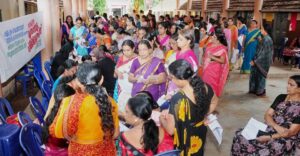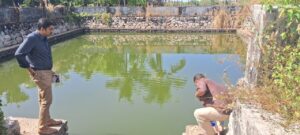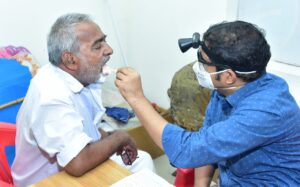ASHA and Kudumbashree workers played a crucial role, mobilising women for weekly screenings and ensuring follow-up treatments in collaboration with the Malabar Cancer Centre.
Published Aug 20, 2025 | 9:00 AM ⚊ Updated Aug 20, 2025 | 11:40 AM

A lung cancer awareness camp conducted at Kannapuram on 1 August, which is observed as World Lung Cancer Day. (Supplied)
Synopsis: Kannapuram grama panchayat set an ambitious goal to become cancer-free. From the very beginning, the local body realised that screening camps alone would not suffice. Unless people were aware, informed, and motivated, the dream of a cancer-free community would remain distant. And so, Kannapuram adopted a unique path: awareness first, screening next.
In a quiet corner of Kannur, a grama panchayat has shown the world how hope and awareness can save lives.
The breast cancer control programme of Kannapuram grama panchayat — built on community participation, continuous sensitisation, and breaking the fear and misconceptions around cancer — has now earned international attention after being featured as ‘original research’ in the World Health Organization’s South-East Asia Journal of Public Health.
Documented by doctors of the Malabar Cancer Centre, “The Kannapuram Model” stands as proof that accessible and approachable screening programmes at the grassroots can bring remarkable change.
The study spotlights how a small Kerala village set a big example in grassroots cancer control.
In 2016, Kannapuram grama panchayat set an ambitious goal to become cancer-free. From the very beginning, the local body realised that screening camps alone would not suffice. Unless people were aware, informed, and motivated, the dream of a cancer-free community would remain distant. And so, Kannapuram adopted a unique path: awareness first, screening next.

Women registering for cancer screening.
“When I look back, the idea of a Cancer Free Kannapuram was not born in a meeting room, but in the quiet grief of our own villages,” recalled KV Ramakrishnan, who was president of the Kannapuram Grama Panchayat from 2015 to 2020.
“We had begun to notice an unusual number of cancer cases and deaths across the 14 wards. It was a silent crisis, touching families one after another, and we felt we could no longer remain mere spectators. That was when we decided to launch a comprehensive programme in January 2016, in collaboration with the Malabar Cancer Center at Thalassery,” he added.
According to him, what started as a community concern soon took shape as a movement.
By May 2017, an Early Cancer Detection Clinic was functioning at the Cherukunnu Primary Health Center (now a Family Health Centre) — the first such facility at a PHC in the state.
It was inaugurated by then Health Minister KK Shailaja, a moment that gave us confidence that this experiment from a small panchayat could set an example, Ramakrishnan recalled.
The guidance of Dr. Satheesan Balasubramanian, MCC Director, was crucial; he reminded us that if fear was removed and people were encouraged to undergo screening, early detection and scientific treatment could save lives.
From health exhibitions linked to temple festivals, to house-to-house surveys, awareness classes, cultural programmes, and massive screening camps — every activity was designed to break the taboo and create hope.
“It was the shared belief of a local body that cancer could be fought, and that belief gave birth to our Cancer Free Kannapuram mission,” he told South First.
“It was the vision of the 2015 panchayat committee. They began with breast cancer screening, but only after a sustained series of awareness programmes. The community first had to understand why screening mattered,” said Vidhya P, current chairperson of the Health Standing Committee, Kannapuram, to South First.

A cancer awareness event organized as part of the Jackfruit fest at Kannapuram in 2018.
When the present committee assumed office, the initiative was strengthened further.
“Our initial focus was on women. We started with breast cancer and then moved to cervical cancer. The Family Health Centre was upgraded with facilities like cryotherapy (or (cryoablation, the use of extreme cold to freeze and remove abnormal tissue, used in some cancers, including prostate, cervical and liver cancer) and a colposcope machine (an essential in gynaecological examinations due to its ability to detect early signs of cervical cancer and other abnormalities), enabling effective diagnosis and early intervention,” Vidhya added.
ASHA and Kudumbashree workers played a crucial role, mobilising women for weekly screenings and ensuring follow-up treatments in collaboration with the Malabar Cancer Centre (MCC).
This tightly knit support system — field-level health workers, elected representatives, and women’s collectives — made the programme robust.
Dr. Phinse Philip, from the Department of Preventive and Community Oncology, MCC, who co-authored the study featured in the journal, highlighted why this model stands out.
“Normally, healthcare workers survey 100 people, but only 40–50 turn up for screening. The gap is due to fear and misconceptions. Kannapuram tackled this by prioritising awareness. Messages were delivered in community spaces — temples, mosques, churches, and cultural gatherings — in ways that didn’t feel forced. This built trust and participation,” he explained to South First.
The programme’s first two years were dedicated almost entirely to awareness building. Only after this groundwork did screening camps begin. The results soon became evident.
In a community where women were once hesitant, screening became linked with empowerment, said Dr Phinse.
Ownership of the programme largely rested with women, from mobilisation to follow-up care. The local panchayat, district panchayat, NGOs, and other stakeholders ensured financial support for follow-up tests like mammograms, so cost would not deter participation.
According to him, the Kannapuram model demonstrates that cancer control is not just a medical effort but a community movement — one where collective ownership, sustained awareness, and grassroots-level empowerment can make a decisive difference in saving lives.
The study, carried out by doctors from the Department of Preventive and Community Oncology and the Department of Surgical Oncology at the MCC has highlighted a unique, community-participatory model for cancer control piloted in Kannapuram Grama Panchayat. The initiative demonstrates how local governance, medical expertise, and grassroots participation can combine to improve cancer awareness, screening, and treatment adherence.
Breast cancer accounts for 26.6 percent of cancers among Indian women. Late-stage presentation, often caused by fear and lack of awareness, contributes to high mortality.

Water samples being collected for testing for potential carcinogens at Kannapuram. (Supplied)
The Kannapuram initiative directly addressed these issues by focusing on early detection and alleviation of fear through community-centered interventions.
The programme began with sensitizing workshops for stakeholders, including Local Self Government Institution members, Primary Health Centre staff, and self-help groups.
Community volunteers conducted house-to-house surveys in 3,800 homes to gather baseline health data and identify high-risk individuals.
Initial hesitation among residents underscored the urgent need to address misconceptions and fear surrounding cancer.
During the second year, sustained, multifaceted awareness activities were introduced.
These included information dissemination through exhibitions, rallies, and IEC materials, as well as creative engagements like literary competitions, survivor-led “winners’ meets,” and food festivals promoting healthy diets.
Schools also hosted cancer and tobacco awareness drives with the involvement of parent-teacher associations.
Observances of national and global cancer-related days reinforced continuity.
In the third year, the Panchayat launched a 10-day breast cancer screening camp, preceded by a single-day registration drive.

An oral cancer screening camp at Kannapuram. (Supplied)
Out of 3,247 eligible women, 3,118 (96 percent) participated. A total of 203 (6.2 percent) were referred, of which 135 underwent further investigations. Importantly, all detected cancers were in early stages, improving chances of successful treatment.
The study concludes that continuous community sensitization, female-led navigation support, and culturally tailored interventions culminated in the successful “Kannapuram Model.”
However, one-third of referred women failed to pursue follow-up investigations, mainly due to lingering fear—highlighting the need for further research into overcoming such barriers.
According to Vidhya, after focusing entirely on women, the grama panchayat has now shifted its attention towards tackling oral and lung cancers, especially among men.
“On 1 August, observed as World Lung Cancer Day, we decided to focus our attention on lung cancer. On 18, 22, and 26 August, lung cancer awareness camps will be conducted,” said Vidhya.
She emphasized that the success of any community-driven cancer awareness programme depends on coordination—likeminded people from all sections coming together for a common cause.
The Kannapuram model has already inspired many other local bodies to take similar initiatives, added her.
Another pioneering example is the First Check Programme of the Pothencode block panchayat, launched in 2022 in collaboration with the Regional Cancer Centre, Thiruvananthapuram.
What makes it stand out is not just its emphasis on awareness and screening, but also its continuity, dedicated funding, and accessibility for all residents.
The monthly awareness and screening programme is being seen as a potential new benchmark for early detection and government-led cancer care.
The Kannapuram model shows that when awareness leads the way and communities take ownership, cancer control becomes more than a health intervention — it becomes a social movement.
By turning fear into empowerment and participation into prevention, this small panchayat has offered the world a template for grassroots-driven cancer care that can save countless lives.
(Edited by Majnu Babu).
